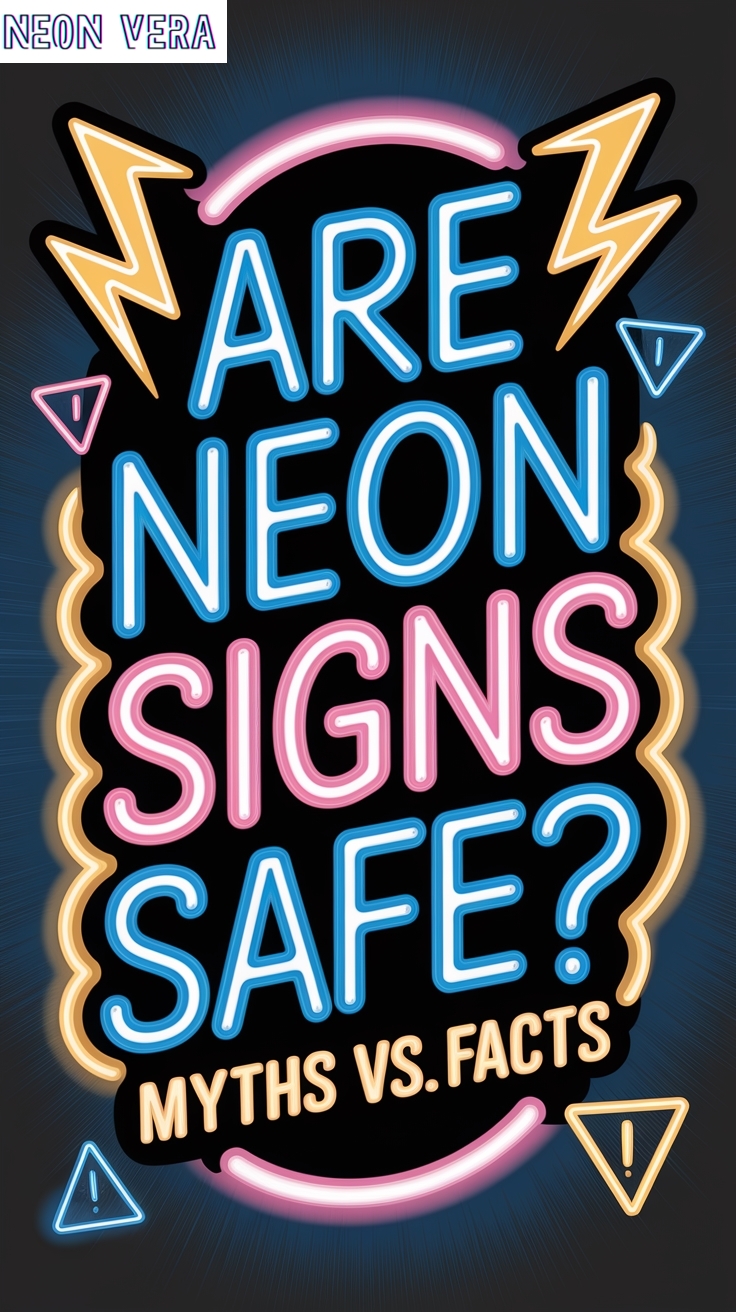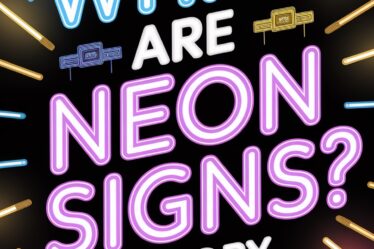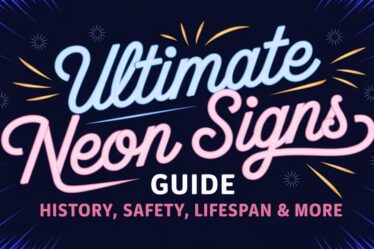
Neon signs are safe when properly installed and maintained by professionals. Modern neon signs feature essential safety components including circuit breakers, protective coatings, and automatic shut-off systems. Though they use higher voltages than LED options, correct installation and upkeep minimize potential risks. Pure neon gas poses no danger, while sealed tubes prevent any exposure concerns. Let’s explore the facts behind other common misconceptions about neon sign safety.
Common Myths About Neon Signs
You’ve likely heard several misleading claims about neon signs that need clearing up.
Three persistent myths suggest that neon signs are toxic, pose significant fire hazards, and break at the slightest touch.
Let’s examine these misconceptions about toxicity concerns, fire risks, and fragility to separate fact from fiction.
Myth 1: Toxicity Concerns
Modern neon signs are safe when properly installed and maintained, despite common misconceptions about toxicity.
While some people worry about harmful elements, today’s signs use secure materials with minimal health risks. Pure neon gas is harmless, and properly sealed tubes prevent any exposure concerns.
Professionally manufactured and installed neon signs have little impact on the environment.
The inert gases remain stable and don’t interact with other substances. The glass tubes effectively contain the gas, ensuring safe operation.
Myth 2: Fire Hazards
Modern neon signs are safe from fire risks when properly installed and maintained, generating less heat than traditional incandescent lighting.
Professional installation is essential to prevent electrical issues and ensure correct wiring.
Having certified technicians handle installation guarantees compliance with safety codes and proper emergency protocols. They ensure proper insulation, secure mounting, and compatible transformer specifications.
Regular maintenance checks help identify potential problems early, preserving your neon sign’s safety and appearance.
Myth 3: Fragility
Despite common perceptions about neon sign fragility, modern displays are sturdy and can handle routine use when properly maintained. Well-designed storage and careful handling significantly extend the life of neon signs.
| Component | Durability Factor | Breakage Prevention |
|---|---|---|
| Glass Tubes | Heat-resistant | Cushioned mounting |
| Electrodes | Weather-sealed | Protective coating |
| Transformers | Impact-resistant | Secure installation |
Modern repair methods have simplified fixing damaged neon signs. The modular construction in current designs enables easy component replacement, reducing repair costs and downtime.
Facts About Neon Sign Safety
You’ll find that modern neon signs come equipped with essential safety features like circuit breakers and protective coatings that prevent electrical hazards.
When installed and maintained properly, your neon sign poses minimal risk compared to other electrical fixtures in your business.
However, you should be aware of potential risk factors such as water exposure, physical damage, and improper wiring that can compromise the sign’s safety.
Built-In Safety Features
Despite their bright, electrified appearance, modern neon signs come equipped with several essential safety features that protect both users and property.
Built-in insulation prevents electrical leakage, while shock-resistant housing protects internal components from impacts.
Temperature control systems regulate heat output, preventing overheating and potential fires.
Modern designs incorporate automatic shut-off mechanisms and surge protection.
Today’s neon signs combine LED-hybrid technology with improved transformers for enhanced safety and cost efficiency.
These innovations ensure safe operation while maintaining their vibrant glow.
Risk Factors
Although modern neon signs incorporate numerous safety features, they still carry specific risk factors that users should understand.
Regular evaluation of your neon sign and proper electrical safety measures help prevent potential hazards. Inspect transformers, wiring, and tubes for damage during safety assessments.
Environmental factors like extreme temperatures and moisture can impact the sign’s structural integrity.
Proper safety training helps users spot early warning signs and maintain neon installations, minimizing accident risks.
Practical Safety Tips
You’ll need a licensed professional to properly install your neon sign, ensuring it meets local electrical codes and safety standards.
When maintaining your sign, it’s essential to regularly check for loose connections, damaged tubes, or worn transformers while keeping the sign clean and free from dust accumulation.
If you notice any flickering, buzzing, or discoloration, don’t attempt repairs yourself – contact a qualified technician immediately.
Installation Guidelines
When installing neon signs, proper safety protocols make the difference between a secure installation and a potential hazard.
Choose your neon sign location thoughtfully, keeping it away from flammable materials and mounting it securely.
Always use approved installation materials, including proper brackets and mounting hardware rated for your sign’s weight.
Professional installation ensures correct electrical connections and compliance with local codes, despite the appeal of DIY.
Before purchase, verify that your sign has relevant safety certifications, such as UL listing, and hire licensed electricians who understand neon-specific requirements.
Maintenance Advice
Regular cleaning and inspection of neon signs extends their lifespan and prevents safety issues.
While powered off, dust your sign monthly using a soft, dry cloth. For deeper cleaning, apply a mild glass cleaner carefully, avoiding any electrical parts.
Schedule electrical inspections twice per year to check for wiring problems and loose connections. If sections flicker or dim, have a professional replace the bulbs promptly.
While basic cleaning is safe to do yourself, complex repairs require certified technicians familiar with high-voltage systems.
Comparing Neon Signs with LED Alternatives
While traditional neon signs operate at higher voltages and require expert installation, LED alternatives offer a safer plug-and-play solution you can install yourself.
You’ll notice LEDs consume less energy and rarely break, but they can’t match the warm, distinctive glow and artistic characteristics of genuine neon.
When choosing between the two, you’ll need to weigh practical benefits against visual appeal, considering that LEDs offer modern convenience while neon delivers classic authenticity.
Safety Differences
Neon and LED signs serve similar purposes but have distinct safety characteristics. Neon signs require delicate handling due to glass tubes and high-voltage transformers, while LEDs incorporate durable plastics and low-voltage parts. Electrical safety protocols are stricter for neon installations, requiring specialized expertise to meet signage standards.
| Safety Aspect | Neon Signs | LED Signs |
|---|---|---|
| Voltage | High (1000-15000V) | Low (12-24V) |
| Breakage Risk | High/Glass | Low/Plastic |
| Fire Risk | Moderate | Minimal |
LED signs prove more practical for various environments, with reduced risk of damage and minimal safety requirements during maintenance.
Aesthetic and Functional Trade-Offs
Beyond safety considerations, neon and LED signs offer distinct aesthetic and functional qualities that appeal to different users.
Neon creates a warm, organic look through its signature glow and flowing lines. While LEDs excel in energy efficiency and installation versatility, they can’t fully replicate neon’s classic visual impact.
Modern LED signs enable quick customization and programming options, while neon signs deliver authentic vintage-style displays.
Your choice between the two ultimately depends on balancing power consumption, maintenance needs, and desired ambiance.
Applications in Different Settings
You’ll find neon signs serving distinct purposes in both commercial and domestic settings, with businesses relying on them for eye-catching storefront displays and advertising.
In commercial spaces, these signs often feature company logos, “OPEN” messages, or menu items that draw customers’ attention even from considerable distances.
While traditionally associated with businesses, you can now incorporate custom neon signs into your home as artistic statements or mood lighting in entertainment rooms, bars, or even children’s bedrooms.
Commercial Use
Although neon signs first gained popularity in the early 1900s, they’ve maintained their status as versatile marketing tools across diverse commercial settings.
Today’s businesses use neon’s distinctive glow for everything from storefront displays to interior design elements. Neon signs create visual impact in restaurants, retail shops, bars, and entertainment venues. Their vibrant colors and unique designs capture customer attention, making them essential for marketing.
Whether you’re running a small boutique or managing a large establishment, neon signs offer a proven way to stand out in competitive markets.
Domestic Use
While neon signs were once exclusive to commercial spaces, they’ve become increasingly popular in homes. These illuminated artworks transform residential spaces with their distinctive glow and creative appeal. Modern neon signs blend seamlessly with interior design while providing functional lighting.
| Setting | Benefits | Considerations |
|---|---|---|
| Living Room | Creates ambiance | Energy consumption |
| Home Office | Personal branding | Heat output |
| Game Room | Entertainment value | Installation needs |
Success with neon signs depends on strategic placement and regular maintenance. LED neon alternatives provide a safer, energy-efficient option while preserving the classic neon look.
Conclusion
When properly installed and maintained, neon signs pose minimal safety risks. You can select either traditional neon or LED options based on your preferences and requirements.
Partner with qualified professionals for installation, schedule routine inspections, and follow electrical safety protocols to enjoy your illuminated display.




Hi, this is a comment.
To get started with moderating, editing, and deleting comments, please visit the Comments screen in the dashboard.
Commenter avatars come from Gravatar.